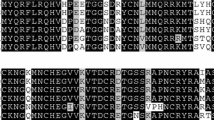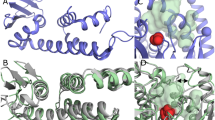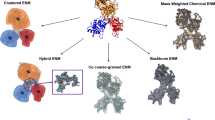Abstract
Eight active canonical members of the pancreatic-like ribonuclease A (RNase A) superfamily have been identified in human. All structural homologs share similar RNA-degrading functions, while also cumulating other various biological activities in different tissues. The functional homologs eosinophil-derived neurotoxin (EDN, or RNase 2) and eosinophil cationic protein (ECP, or RNase 3) are known to be expressed and secreted by eosinophils in response to infection, and have thus been postulated to play an important role in host defense and inflammatory response. We recently initiated the biophysical and dynamical investigation of several vertebrate RNase homologs and observed that clustering residue dynamics appear to be linked with the phylogeny and biological specificity of several members. Here we report the 1H, 13C and 15N backbone resonance assignments of human EDN (RNase 2) and its molecular dynamics simulation on the microsecond timescale, providing means to pursue this comparative atomic-scale functional and dynamical analysis by NMR and computation over multiple time frames.





Similar content being viewed by others
Change history
06 August 2018
After publication of this article, the authors noticed that a 15N–13C dimension error was unwillingly coded in the 3D NMR spectrum “fid.com” processing script used to perform backbone assignments for this enzyme. The authors noticed that some OBS, CAR and LAB values in the “fid.com” had been switched in the y and z dimensions, probably resulting from a wrong NMRPipe selection when reading the Varian NMR experimental parameters. They have carefully re-processed, re-analyzed, re-assigned, in addition to checking all scripts to evaluate the extent of this processing error on the published assignments. Authors determined that the “fid.com” error resulted in a significant number of incorrect backbone resonance assignments, requiring us to issue corrections in Figs. 2, 3 and 4 of this published manuscript, in addition to Table S1. New versions of these figures and table are provided below. The corresponding BMRB entry has also been revised. The authors note that these modifications do not change the global message, conclusions, and molecular dynamics simulations presented in this article. The authors are grateful to David N. Bernard (INRS) for help with finding and correcting these errors.
References
Ackerman SJ, Gleich GJ, Loegering DA, Richardson BA, Butterworth AE (1985) Comparative toxicity of purified human eosinophil granule cationic proteins for schistosomula of Schistosoma mansoni. Am J Trop Med Hyg 34:735–745
Agarwal PK (2004) Cis/trans isomerization in HIV-1 capsid protein catalyzed by cyclophilin A: insights from computational and theoretical studies. Proteins 56:449–463
Armougom F, Moretti S, Poirot O, Audic S, Dumas P, Schaeli B et al (2006) Expresso: automatic incorporation of structural information in multiple sequence alignments using 3D-Coffee. Nucleic Acids Res 34:W604–W608
Berjanskii MV, Wishart DS (2005) A simple method to predict protein flexibility using secondary chemical shifts. J Am Chem Soc 127:14970–14971
Boix E, Leonidas DD, Nikolovski Z, Nogues MV, Cuchillo CM, Acharya KR (1999) Crystal structure of eosinophil cationic protein at 2.4 Å resolution. BioChemistry 38:16794–16801
Carreras E, Boix E, Rosenberg HF, Cuchillo CM, Nogues MV (2003) Both aromatic and cationic residues contribute to the membrane-lytic and bactericidal activity of eosinophil cationic protein. BioChemistry 42:6636–6644
Case D, Babin V, Berryman J, Betz R, Cai Q, Cerutti D et al. (2014) Amber 14, University of California, San Francisco
Chang KC, Lo CW, Fan TC, Chang MD, Shu CW, Chang CH et al. (2010) TNF-alpha mediates eosinophil cationic protein-induced apoptosis in BEAS-2B cells. BMC Cell Biol 11:6
Domachowske JB, Dyer KD, Bonville CA, Rosenberg HF (1998) Recombinant human eosinophil-derived neurotoxin/RNase 2 functions as an effective antiviral agent against respiratory syncytial virus. J Infect Dis 177:1458–1464
Gagné D, Doucet N (2013) Structural and functional importance of local and global conformational fluctuations in the RNase A superfamily. FEBS J 280:5596–5607
Gagné D and Doucet N (2015) Sequence-specific backbone 1H, 13C, and 15N resonance assignments of human ribonuclease 4. Biomol NMR Assign 9:181–185
Gagné D, Charest LA, Morin S, Kovrigin EL, Doucet N (2012) Conservation of flexible residue clusters among structural and functional enzyme homologues. J Biol Chem 287:44289–44300
Gagné D, French RL, Narayanan C, Simonovic M, Agarwal PK, Doucet N (2015a) Perturbation of the conformational dynamics of an active-site loop alters enzyme activity. Structure 23:2256–2266
Gagné D, Narayanan C, Doucet N (2015b) Network of long-range concerted chemical shift displacements upon ligand binding to human angiogenin. Protein Sci 24:525–533
Hamann KJ, Barker RL, Loegering DA, Gleich GJ (1987) Comparative toxicity of purified human eosinophil granule proteins for newborn larvae of Trichinella spiralis. J Parasitol 73:523–529
Hamann KJ, Gleich GJ, Checkel JL, Loegering DA, McCall JW, Barker RL (1990) In vitro killing of microfilariae of Brugia pahangi and Brugia malayi by eosinophil granule proteins. J Immunol 144:3166–3173
Han B, Liu Y, Ginzinger SW, Wishart DS (2011) SHIFTX2: significantly improved protein chemical shift prediction. J Biomol NMR 50:43–57
Lehrer RI, Szklarek D, Barton A, Ganz T, Hamann KJ, Gleich GJ (1989) Antibacterial properties of eosinophil major basic protein and eosinophil cationic protein. J Immunol 142:4428–4434
Leonidas DD, Boix E, Prill R, Suzuki M, Turton R, Minson K et al (2001) Mapping the ribonucleolytic active site of eosinophil-derived neurotoxin (EDN). High resolution crystal structures of EDN complexes with adenylic nucleotide inhibitors. J Biol Chem 276:15009–15017
Mosimann SC, Newton DL, Youle RJ, James MN (1996) X-ray crystallographic structure of recombinant eosinophil-derived neurotoxin at 1.83 Å resolution. J Mol Biol 260:540–552
Rosenberg HF, Tenen DG, Ackerman SJ (1989) Molecular cloning of the human eosinophil-derived neurotoxin: a member of the ribonuclease gene family. Proc Natl Acad Sci USA 86:4460–4464
Rugeles MT, Trubey CM, Bedoya VI, Pinto LA, Oppenheim JJ, Rybak SM et al (2003) Ribonuclease is partly responsible for the HIV-1 inhibitory effect activated by HLA alloantigen recognition. AIDS 17:481–486
Shen Y, Delaglio F, Cornilescu G, Bax A (2009) TALOS+: a hybrid method for predicting protein backbone torsion angles from NMR chemical shifts. J Biomol NMR 44:213–223
Sikriwal D, Seth D, Batra JK (2009) Role of catalytic and non-catalytic subsite residues in ribonuclease activity of human eosinophil-derived neurotoxin. Biol Chem 390:225–234
Sikriwal D, Seth D, Parveen S, Malik A, Broor S, Batra JK (2012) An insertion in loop L7 of human eosinophil-derived neurotoxin is crucial for its antiviral activity. J Cell Biochem 113:3104–3112
Slifman NR, Loegering DA, McKean DJ, Gleich GJ (1986) Ribonuclease activity associated with human eosinophil-derived neurotoxin and eosinophil cationic protein. J Immunol 137:2913–2917
Swaminathan GJ, Holloway DE, Veluraja K, Acharya KR (2002) Atomic resolution (0.98 Å) structure of eosinophil-derived neurotoxin. BioChemistry 41:3341–3352
Torrent M, Cuyas E, Carreras E, Navarro S, Lopez O, de la Maza A et al (2007) Topography studies on the membrane interaction mechanism of the eosinophil cationic protein. BioChemistry 46:720–733
Wang L, Eghbalnia HR, Bahrami A, Markley JL (2005) Linear analysis of carbon-13 chemical shift differences and its application to the detection and correction of errors in referencing and spin system identifications. J Biomol NMR 32:13–22
Wilkins MR, Gasteiger E, Bairoch A, Sanchez JC, Williams KL, Appel RD et al (1999) Protein identification and analysis tools in the ExPASy server. Methods Mol Biol 112:531–552
Yang D, Rosenberg HF, Chen Q, Dyer KD, Kurosaka K, Oppenheim JJ (2003) Eosinophil-derived neurotoxin (EDN), an antimicrobial protein with chemotactic activities for dendritic cells. Blood 102:3396–3403
Yang D, Chen Q, Rosenberg HF, Rybak SM, Newton DL, Wang ZY et al (2004) Human ribonuclease A superfamily members, eosinophil-derived neurotoxin and pancreatic ribonuclease, induce dendritic cell maturation and activation. J Immunol 173:6134–6142
Yang D, Chen Q, Su SB, Zhang P, Kurosaka K, Caspi RR et al (2008) Eosinophil-derived neurotoxin acts as an alarmin to activate the TLR2-MyD88 signal pathway in dendritic cells and enhances Th2 immune responses. J Exp Med 205:79–90
Young JD, Peterson CG, Venge P, Cohn ZA (1986) Mechanism of membrane damage mediated by human eosinophil cationic protein. Nature 321:613–616
Acknowledgements
The authors thank Tara Sprules (Québec/Eastern Canada High Field NMR Facility, McGill University) and Sameer Al-Abdul-Wahid (NMR Centre, University of Guelph) for their excellent technical assistance, in addition to David Bernard (INRS-Institut Armand-Frappier) and Bruce Johnson (CUNY Advanced Science Research Center) for helpful discussions. This work was supported by the National Institute of General Medical Sciences (NIGMS) of the NIH under award number R01GM105978 (to N.D. and P.K.A.), and a Natural Sciences and Engineering Research Council of Canada (NSERC) Discovery Grant under award number RGPIN-2016-05557 (to N. D.). N.D. holds a Fonds de Recherche Québec – Santé (FRQS) Research Scholar Junior 2 Career Award. C.N. is the recipient of a postdoctoral fellowship from the Fondation Universitaire Armand-Frappier de l’INRS. D.G. and L.A.C. were respectively recipients of an NSERC Alexander Graham Bell Canada Graduate Scholarship and a M.Sc. scholarship from the Fondation Universitaire Armand-Frappier de l’INRS.
Author information
Authors and Affiliations
Corresponding author
Electronic supplementary material
Below is the link to the electronic supplementary material.
Rights and permissions
About this article
Cite this article
Gagné, D., Narayanan, C., Bafna, K. et al. Sequence-specific backbone resonance assignments and microsecond timescale molecular dynamics simulation of human eosinophil-derived neurotoxin. Biomol NMR Assign 11, 143–149 (2017). https://doi.org/10.1007/s12104-017-9736-9
Received:
Accepted:
Published:
Issue Date:
DOI: https://doi.org/10.1007/s12104-017-9736-9




